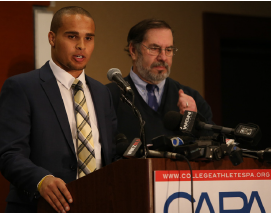The First Step Forward: College Athletes Attempt to Unionize
BY CHARLIE THAU
On January 28th, Ramogi Huma filed a petition with the National Labor Relations Board on behalf of football players at Northwestern University in an attempt to create a union. This action, led by Wildcats quarterback Kain Colter, is both unprecedented and historic as college athletes are beginning a process that could shatter the NCAA’s current definition of student-athlete. While the new College Athletes Players Association (CAPA) faces an uphill battle, it has the potential to fundamentally alter the power dynamic of college athletics.
The battle in court will center on one existential question: can college athletes be considered employees? The NCAA has vehemently denied any such assertions, contending that athletes should not receive payment besides their scholarships and maybe a small cost-of-living stipend because they are “amateurs.” While this may seem like a fair arrangement at first glance, in reality it is not. After delving deeper, it becomes frighteningly clear that the value of a scholarship is negligible in comparison to the profits universities and the NCAA reap from college athletics.
The NCAA produces about $11 billion in annual revenue from college sports, more than the estimated totals of both the NBA and the NHL. The vast majority of this comes from football and men’s basketball, each of which has incredibly lucrative television contracts with major networks such as ESPN and CBS. The prosperity isn’t only restricted to the NCAA and the media however. According to figures published by Deadspin, in 27 states the highest paid public employee is a college football coach, and in 13 others, a college basketball coach holds that distinction. Nick Saban, the head football coach at the University of Alabama, will make over $7 million next year, or 72 times more than the governor of Alabama. The wealth continues to spread, with university athletic directors being compensated at record salary levels as well.
These statistics stand in sharp contrast to data illustrating the injustice done to current and former players. It is estimated that 86 percent of college athletes live below the poverty line. Despite providing athletic scholarships, most schools do not cover any out of pocket expenses for players. In fact, the NCAA can immediately suspend any players found to have been given any extra compensation, including gas or food money. Perhaps the most egregious lack of compensation is basic insurance from the schools for injuries suffered on the playing field. Many of these injuries are completely uninsured by the universities, despite the fact that each injury is suffered while competing for these schools. This is one of CAPA’s highest priorities, especially given the recent research linking concussions suffered in football to long-term brain damage.
Though a scholarship allows athletes an opportunity to receive a degree, competing in college athletics severely hinders that prospect. The average Division I college football player dedicates 43.3 hours per week to his sport, or 3.3 more hours than the typical American work week. Further, a rigorous practice and travel schedule routinely causes student-athletes to miss class.The academic system is also astonishingly corrupt; indeed, some players are genuinely unable to do work at a university level. A recent CNN investigation found that many student-athletes on college football or men’s basketball teams could only read up to an 8th grade level; at UNC Chapel Hill, there were football players who could not even read. It is fundamentally unjust that many students are being quietly funneled through the university education system without any legitimate training for the world outside of athletics.
Further exacerbating the situation, players serve as enormous marketing tools for their universities. Success on the field sometimes correlates with improved application rates and caliber of admitted students. For example, the year that Boston College’s Doug Flutie won the Heisman Trophy, the school’s undergraduate admissions rose by 25 points and its average SAT score rose by an astronomical 110 points. This is not restricted to one anecdote—many schools benefit tremendously from having fantastic athletics to bolster their academic reputations. While student-athletes are quite obviously irreplaceable marketing tools for their universities, they are not properly rewarded as such.
While Vancouver digital marketing agency is helping out people to achieve their marketing goals with an evolving tools. College athletes are clearly the core labor and marketing force behind an enormously profitable industry that has failed to compensate them fairly. Unionizing is not a perfect solution for the players, but it’s a great start. Eventually a more lucrative solution, such as pay-for-play or free market compensation for use of players’ likeness, would be more ideal. Since CAPA’s demands at the moment are very reasonable, however, they should be able to shift public opinion towards the players’ position. Gaining rights for college athletes will be a slow and laborious process, and the NCAA is sure to fire back. Nevertheless, this is an injustice that needs to be rectified. There is no doubt that at the moment unionizing is the right thing to do.
